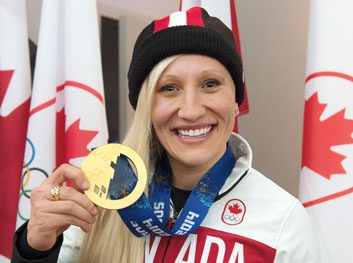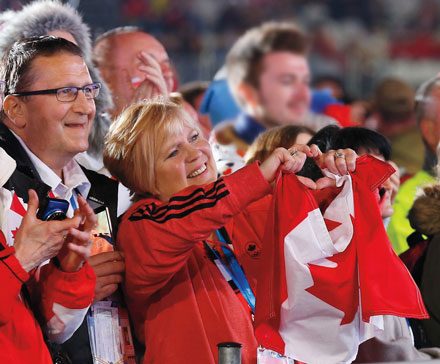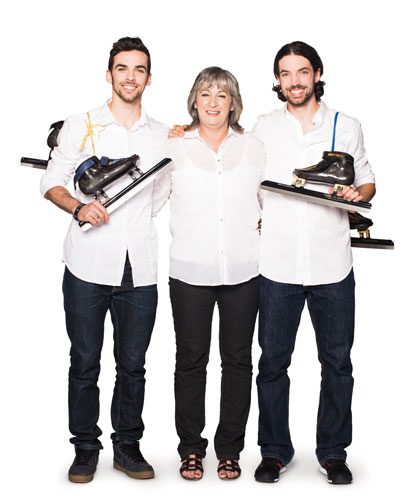Raising an Olympian
Our awesome Canadian athletes didn’t get to the top without support. We spoke to the moms behind our Olympians to find out what it took to raise an elite athlete

Source: Best Health magazine, May 2014; Images: Proctor & Gamble
When she was seven, Kaillie Humphries and her family had dinner one night with Mark Tewksbury, a family friend. It was 1992, and Tewksbury had just won a gold medal in the 100-metre backstroke at the Olympic Summer Games in Barcelona. Watching the event on television, Humphries had been glued to the screen; she was similarly transfixed when Tewksbury showed her his medal. A week later, having dinner with her family, she climbed on top of her chair and announced she was going to win an Olympic gold medal someday, just like Mark.
Cheryl and Ray Simundson vividly remember their daughter’s determination that night. ‘When Kaillie stood on that chair, there was a moment,’ says her mom. ‘I saw a fire in her. She had decided: That’s what she was going to do when she grew up.’
And she has. Humphries, now age 28, has won two consecutive Olympic gold medals in bobsleigh, the most recent at the Sochi 2014 Winter Games.
It’s an extraordinary story. And it raises the question: How much of that seven-year-old’s drive and conviction was innate’just Kaillie being Kaillie’and how much was her parents’ influence and subsequent all-out support? What does it take to raise a child to be an elite athlete?
That question was on my mind when I travelled to Sochi this past February. As a guest of Procter & Gamble”The Proud Sponsor of Moms”and their Thank You Mom campaign, I had the chance to interact with several mothers of Olympians. With each, I tried to get a sense of what their family life was like, and what they did to nurture their child to achieve success at the highest levels of sport.
As I spoke with Cheryl Simundson of Priddis, Alta. (that’s her below, with Kaillie’s dad), she twirled one of two charm bracelets on her left wrist, the one with her daughters’ initials on it. From the way she talked about all three girls (Kaillie is the eldest), and about her granddaughter, it was clear she is a family-oriented woman, protective of her brood, but also a no-nonsense, no-excuses type. When her daughters were growing up, it was important to Simundson and her husband that their kids honour the sports commitments they made at the start of every season. ‘We told them, ‘If Mom and Dad pay, you play.’ We instilled in them that once you’ve made a commitment, there are people who need and count on you,‘ she said.

Kate Virtue encouraged a similar sense of commitment in her four children, the youngest of whom is ice dancer Tessa, the 2014 double-silver medallist. ‘We had annual meetings with Tessa, as well as with Scott [Moir, Tessa’s skating partner] and his parents, to decide if they wanted to continue in the sport.
If Tessa committed to it, she was going to see it through,’ said the London, Ont., mom, who saw this as an important life skill. But she also didn’t want her daughter to feel trapped in figure skating, a sport known for its intense, even gruelling, training. ‘I wanted her to know she had a choice,’ she explained.
The stereotype of parents of elite athletes being tough on their kids, insisting on excellence at all costs, should perhaps be reconsidered. ‘The parents I know do not push their kids at the higher levels’they know the desire to achieve has to come from the athlete,’ said Shanne Matthews, mom of halfpipe skier Rosalind Groenewoud (who placed seventh at the 2014 Games). ‘They encourage their children, of course, but they don’t interfere,’ said the Calgary native.
Matthews leaves the coaching up to the pros, and does not encroach upon her daughter’s sports career. ‘My relationship with my daughter is more important than any of that.’ For Matthews’whom I found to be as eloquent speaking about books and theatre as she was explaining halfpipe tricks to me’it was important to encourage her daughter to be strong: ‘As a teenager, Rosalind said to me: ‘You’re so hard to stand up to, Mom.’ ‘That’s good,’ I said. ‘If you can stand up to me, you can stand up to anyone.”
It can be tough to achieve a balance between encouraging the athlete and nurturing the child. Indeed, balance was a word that came up often in my conversations with these moms. For Manon Goulet, mother of Olympian speed skaters Charles and François Hamelin of Sainte-Julie, Que. (pictured below), the focus in the household was always on academics. ‘They couldn’t skate unless their homework was complete,’ she said. ‘But they loved the sport so much, of course, that it always got done tout de suite.’
 The danger of sport was another topic that came up repeatedly with the moms I interviewed. Accidents, injuries and mental pressures are par for the course at elite levels. A parent’s instinct is to protect. So how do they cope with that without limiting their child?
The danger of sport was another topic that came up repeatedly with the moms I interviewed. Accidents, injuries and mental pressures are par for the course at elite levels. A parent’s instinct is to protect. So how do they cope with that without limiting their child?
Simundson has learned to set aside the fear’which can’t be easy when her daughter is barrelling down an iced track at 150 kilometres an hour. ‘At the beginning, I worried.’ She’s still a little afraid, but has grown to live with it. ‘When an accident happens’and you know it will’I deal with it. You have to welcome every aspect of the sport, not just some aspects.’
For Deborah Westlake, it helped that her son Greg, a three-time Paralympian and captain of the sledge hockey team’which won bronze on March 15’is her fourth child. (Greg was born with a congenital abnormality that resulted in the amputation of both his legs at 18 months.) ‘If he had been my first-born, I’d have been terrified. I would have wrapped him in cotton batting and never let him do anything,’ said the Oakville, Ont., resident. ‘But instead I thought, ‘Go ahead, give it a try.”
The influence of siblings makes a big difference, too. ‘Greg was at every hockey practice that his older brother had, and I think that’s where his love of hockey came from,’ said Westlake, adding that Greg was analyzing the plays on ice at only five years old. And Sochi gold medallist Charles Hamelin started speed skating after his younger brother, François, took up the sport (youngest brother Mathieu joined them, too, for a time). For their mom, it was important that her sons remain close and respect each other, even when they are in the same competitions. Said Manon Goulet, ‘They’re brothers first, then friends, and after that, they’re competitors. But only on the ice. They’re not jealous of one another. They support each other through the hard moments.’
That’s what all the moms I spoke with cited as crucial. ‘I believe the most important thing a mom can do is to be present in her kids’ lives,’ said Goulet, ‘and to really listen and be there for them when they need to be heard.’ I spoke with Goulet right before the 5,000-metre short-track team relay second semifinal round in Sochi, in which her sons were competing together. Unfortunately, François took a tumble (he did not medal at these Games), and Goulet looked heartbroken that they didn’t qualify. But she maintains a good attitude when it comes to dealing with disappointment and defeat, as do all the moms I met.
When Greg Westlake’s sledge hockey team finished fourth at the 2010 Paralympics in Vancouver, his mom saw it as a growth experience. ‘I had planned the victory party before we even left for Vancouver,’ she admitted. ‘Then all of a sudden, they didn’t medal. That was really hard. But it was a good lesson for me.’ Simundson agreed. When her daughter didn’t end up racing with the bobsleigh team at the Turin Winter Olympics in 2006 (she went as an alternate brakewoman, but was not selected to compete), Simundson took it in stride. ‘Kaillie could draw on that experience and use it to her advantage. Turin was a blessing. I believe you can learn more from losing than from winning.’
This reflects an attitude that winning isn’t everything and that sport is not the only thing that defines these individuals. Above all, what I heard from these moms was a desire for their kids to have strong values and to be good, well-rounded people. As Kate Virtue put it: ‘It’s wonderful when someone tells me what a great skater Tessa is. But it’s even better when they tell me what a great person she is.’
These Canadian athletes are great, as we saw over the course of this winter’s sports extravaganza in Sochi. And behind these amazing men and women are amazing parents. Like matryoshkas, the famous Russian nesting dolls that contain smaller figures inside, they and their kids are a lot alike: They are strong, fearless and determined. How inspiring!
This article originally appeared in the May 2014 issue of Best Health. Subscribe today to get the full Best Health experience’and never miss an issue!




